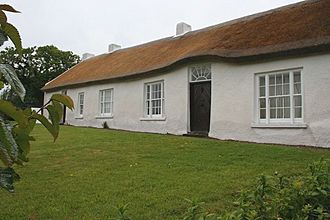Hezlett House facts for kids
Quick facts for kids Hezlett House |
|
|---|---|
 |
|
| Alternative names | Liffock House |
| General information | |
| Town or city | Castlerock |
| Country | Northern Ireland |
| Coordinates | 55°09′18″N 6°47′24″W / 55.155°N 6.7899°W |
| Completed | 1691 |
| Owner | National Trust for Places of Historic Interest or Natural Beauty |
Hezlett House is a very old and special house located in Castlerock, County Londonderry, in Northern Ireland. It was built a long, long time ago, around the year 1691. This makes it one of the oldest buildings in the whole area of Ulster that people still use today!
Hezlett House is known as a thatched cottage. This means its roof is made from dried straw or reeds, which was a common way to build roofs hundreds of years ago. It sits right at a crossroads near the village, looking like something out of a history book.
What Makes Hezlett House Special?
Hezlett House is unique because of how it was built. It has a special type of frame called a cruck structure. Imagine big, curved wooden beams that look a bit like upside-down boat hulls. These beams go from the ground all the way up to the roof, forming the main support for the house. This was a very old way of building, and not many cruck-framed houses are left today.
A Look Back in Time
When Hezlett House was first built, it wasn't a museum like it is now. It was probably a rectory, which is a house where a church minister or priest lived. Or, it might have been a farmhouse, where a farming family lived and worked. Either way, it was a busy home for people living in the 17th century.
Today, Hezlett House is looked after by the National Trust for Places of Historic Interest or Natural Beauty. They help keep it safe and open so that people can visit and learn about what life was like hundreds of years ago. It's like stepping into a time machine!

